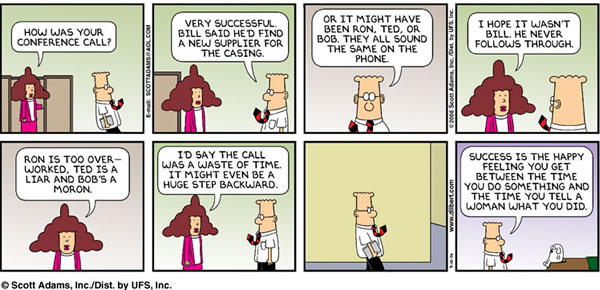September 14, 2006
He bold as a hawk, she soft as the dawn
Last Sunday, Dilbert defined success:
It's true that Alice often punctures the illusions of her co-workers with sharp little barbs of realism. But any regular reader of Scott Adams' strip will know that Dilbert himself often deflates his boss in exactly the same way. So why was Dilbert's take-away message "wasn't that just like a woman" rather than "wasn't that just like me"?
Well, the simple answer is that the alternative wouldn't have been funny. The punchline needs some kind of group connection to get a laugh. Apparently, we get a little jolt of pleasure from recognizing individual behavior as consistent with a group stereotype. And not all groups work equally well. Here Scott Adams might have satirized engineers rather than women -- "Success is the happy feeling you get between the time you do something and the time you tell an engineer what you did" -- but that wouldn't have had nearly as much impact. This is mainly because female stereotypes pack more emotional punch for more people than geek stereotypes do. But I think it's also because the pleasure of humorous stereotyping is especially piquant when it involves a sort of anti-stereotype, a subgroup that's antithetical to a group norm.
This may help explain why hostile and socially aggressive women are stock characters in the literatures of many places and times. There's a stereotype of femininity whose recent neuro-biological variant is represented by Louann Brizendine's view that "[m]aintaining the relationship at all costs is the female brain's goal", because females are "motivated -- on a molecular and a neurological level -- to ease and even prevent social conflict". But there's a corresponding anti-stereotype as well.
According to Yenna Wu ( "The Inversion of Marital Hierarchy: Shrewish Wives and Henpecked Husbands in Seventeenth-Century Chinese Literature", Harvard Journal of Asiatic Studies, 48(2), 363-382, Dec., 1988:
Shrewish wives and henpecked husbands, familiar figures in world literature, make frequent appearance in many periods of Chinese literature and in various literary genres, including classical tales, biji anecdotes, folk songs, jokebooks, vernacular stories, novels and plays.
Wu describes the 17th-century Chinese theories of henpecking in ways that echo today's controversies about sex roles. Shen Defu (1578-1642) saw henpecking as created by the psychodynamics of individuals' power and status:
[He] observed that since the medieval period most officials, even emperors and ministers, had tended to be henpecked husbands. He explains that it is because these high-ranking officials do not wish to lose face by having their wives speak against them in public.
In contrast, Xie Zhaozhe (1567-1624) argued that henpecking is the current residue of interactions in the distant past, just like today's genetic explanations from evolutionary psychologists:
[He] attributed henpecking to predestination ... karmic retribution to punish men for sins they had committed in a previous existence. In his opinion, this is the worst of all punishments, for it is easier to flee from cruel parents, vicious brothers, tyrants or violent friends than from the wife to whom one is tied day and night.
Whatever explanation is given, these nested boxes of stereotype/anti-stereotype pairs are a boon to cartoonists (and neurobiologists), since no matter what someone does, you can say to yourself, "wasn't that just like a <whatever>".
Having started with Dilbert, let's close with some of the great cartoons of James Thurber, the poet laureate of sex-role inversion. In many of his panels, the joke is mostly just the fact that a woman is unexpectedly assertive or hostile:
 |
 |
Those two cartoons would not have been considered funny at all if two men were involved. I'm not sure about two women.
Sometimes the caption is intrinsically amusing, but takes on a special meaning in the context of sex-role inversion:

Thurber echoes Shen Defu in relating women's power to the threat of social embarrassment:

Women's aggression towards men is sometimes open and overt, as in the first two examples above, but Thurber often sees it as covert or sneaky:
 |
 |
And female hostility, for Thurber, usually seems to take the verbal form of gossip rather than direct confrontation when it's aimed at other women (though such gossipy asides are sometimes directed at men as well):
 |
 |
 |
Thurber sometimes does depict women as seductive conversational facilitators -- but in incongruent situations:
 |
 |
The thread that runs through all of these cartoons, it seems to me, is the ironic distance between individuals and the stereotypes they evoke:

